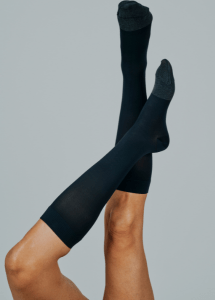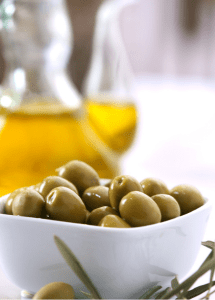5 Things You May Not Be Doing to Help Joint Pain

If you live with joint pain and soreness, you may be searching for more things that you can do to help yourself be more mobile and functional each day. You have probably already been told to rest, apply heat or cold, stretch, and maybe have regular massage or physical therapy. We’ve put together a list of some other things you can do for your joint health and comfort that you may not be doing today, but could really benefit you both short and long term.
Use the C in RICE
 It is common for health professionals to tell people with joint injury or discomfort to use “RICE” – Rest, Ice, Compression, and Elevation. Many people do all of these except the C – compression – even though this “C” is often one the most helpful things you can do. Compression – usually using garments like socks, sleeves, or wraps – applies a gentle but steady pressure to the joint and the area around the joint. While compression in the form of bracing may be recommended right after an injury, it is often forgotten as a valuable strategy in helping to support chronic joint health. [1] Compression does a lot more than provide a sense of stability; it actually improves circulation and reduces inflammation by assisting your body in moving fluid out of the local area and back toward your heart. [2] Compression may be uniform or graduated – graduated compression tends to be a little tighter at the area that is further away from your heart, and is mostly found is socks or stockings. People are often surprised that compression provides relatively rapid relief and can support them in being more active and engaging in exercise, but it can be a very useful tool when applied correctly.
It is common for health professionals to tell people with joint injury or discomfort to use “RICE” – Rest, Ice, Compression, and Elevation. Many people do all of these except the C – compression – even though this “C” is often one the most helpful things you can do. Compression – usually using garments like socks, sleeves, or wraps – applies a gentle but steady pressure to the joint and the area around the joint. While compression in the form of bracing may be recommended right after an injury, it is often forgotten as a valuable strategy in helping to support chronic joint health. [1] Compression does a lot more than provide a sense of stability; it actually improves circulation and reduces inflammation by assisting your body in moving fluid out of the local area and back toward your heart. [2] Compression may be uniform or graduated – graduated compression tends to be a little tighter at the area that is further away from your heart, and is mostly found is socks or stockings. People are often surprised that compression provides relatively rapid relief and can support them in being more active and engaging in exercise, but it can be a very useful tool when applied correctly.
Manage your weight
Body weight has an impact on nearly every kind of arthritis and joint pain, whether it be rheumatic, degenerative, gout, or others. The reasons are complex and multifold, but generally, having excess body weight is associated with more inflammation, which is associated with more pain and possibly more joint damage over time. [3] Excess weight also directly places more pressure on some joints (knees, hips, ankles, and spine), leading to increased mechanical damage. Losing weight can be challenging, but if you believe it is contributing to your pain and limiting your mobility, it’s probably worth the investment. If you don’t know where to start, you can find an Obesity Medicine Specialist who can help you evaluate the best options, from diet to medication.
Consider a Mediterranean diet
 The Mediterranean Diet seems to get credited with all kinds of health benefits, from better heart health and digestive health to lower risk of cancer and generally living a longer life. If you need one more reason to consider it, studies have also show benefits for joint health! By incorporating high levels of foods that decrease inflammation, this diet plan has been shown to address some of the mechanisms that underly many joint conditions. [4] One recent study conducted specifically in women with arthritis actually found a significant improvement in quality of life after using a Mediterranean Diet for just 24 weeks. [5] The basics of the Mediterranean Diet incorporate a high intake of vegetables, whole grains, beans, fish, nuts, and healthy fats. If you are not familiar with the Mediterranean Diet, and would like to know learn the basics of this eating plan, this article from the Cleveland Clinic is a great place to start.
The Mediterranean Diet seems to get credited with all kinds of health benefits, from better heart health and digestive health to lower risk of cancer and generally living a longer life. If you need one more reason to consider it, studies have also show benefits for joint health! By incorporating high levels of foods that decrease inflammation, this diet plan has been shown to address some of the mechanisms that underly many joint conditions. [4] One recent study conducted specifically in women with arthritis actually found a significant improvement in quality of life after using a Mediterranean Diet for just 24 weeks. [5] The basics of the Mediterranean Diet incorporate a high intake of vegetables, whole grains, beans, fish, nuts, and healthy fats. If you are not familiar with the Mediterranean Diet, and would like to know learn the basics of this eating plan, this article from the Cleveland Clinic is a great place to start.
Sign up for a yoga class
 Engaging in exercise can be a mixed bag if you have joint discomfort, and it may feel intimidating to know where to start or what you can do safely without doing more harm than good. The practice of Yoga has been studied to benefit joint pain [6], so it is worth considering if you are unsure of where to start. A study of people engaging in yoga for even just one week found improvements in pain and function [7], and longer studies have shown an impact on far-ranging outcomes, from biomarkers to mood. [8]
Engaging in exercise can be a mixed bag if you have joint discomfort, and it may feel intimidating to know where to start or what you can do safely without doing more harm than good. The practice of Yoga has been studied to benefit joint pain [6], so it is worth considering if you are unsure of where to start. A study of people engaging in yoga for even just one week found improvements in pain and function [7], and longer studies have shown an impact on far-ranging outcomes, from biomarkers to mood. [8]
* A word of caution: there are many kinds of yoga and instructors of varying skill. Try to find a certified teacher in your area, and start with beginner classes so you can learn the basic practice of yoga before moving on to more advanced techniques.
Moderate Caffeine
 If you ask knowledgeable health professionals (or even Dr. Google!) about caffeine and joint pain, the answer you may get is “it’s complicated.” Caffeine is often found in combination with medications like acetaminophen (paracetamol) and ibuprofen because of its synergistic effects. Caffeine also acts on adenosine receptors (receptors that contribute to our perception of pain), so it may have a separate, more direct effect on pain as well. [9] That said, some studies in joint pain have indicated that caffeine may cause more progression of joint problems [10] or increase symptoms and flare-ups. [11] To understand how caffeine affects your joints, you may need pay some direct attention to how much you are consuming and how it makes feel. One way to do this is to stop caffeine for a time, and then reintroduce it slowly to see how your joints feel. Keeping a journal of your symptoms together with your caffeine intake can help to create a clear picture of your personal reaction. It is always advisable to try to keep your daily caffeine intake at or below 400mg, which is considered to be a safe intake limit for adults.
If you ask knowledgeable health professionals (or even Dr. Google!) about caffeine and joint pain, the answer you may get is “it’s complicated.” Caffeine is often found in combination with medications like acetaminophen (paracetamol) and ibuprofen because of its synergistic effects. Caffeine also acts on adenosine receptors (receptors that contribute to our perception of pain), so it may have a separate, more direct effect on pain as well. [9] That said, some studies in joint pain have indicated that caffeine may cause more progression of joint problems [10] or increase symptoms and flare-ups. [11] To understand how caffeine affects your joints, you may need pay some direct attention to how much you are consuming and how it makes feel. One way to do this is to stop caffeine for a time, and then reintroduce it slowly to see how your joints feel. Keeping a journal of your symptoms together with your caffeine intake can help to create a clear picture of your personal reaction. It is always advisable to try to keep your daily caffeine intake at or below 400mg, which is considered to be a safe intake limit for adults.
Joint pain can have a big impact on your quality of life, and it’s good to remember that there are lots of safe options of things that you can try on your own. That being said, if you are having a lot of discomfort, or if your pain or associated symptoms seem to be getting worse, you should always contact your trusted health professional for further medical advise.
[1] McKnight PT, Kwoh CK. Randomized, controlled trial of compression gloves in rheumatoid arthritis. Arthritis Rheum. 1992;5(4):223-227. doi:10.1002/art.1790050407
[2] MacRae BA, Cotter JD, Laing RM. Compression Garments and Exercise. Sports Med. 2011;41(10):815-843. doi:10.2165/11591420-000000000-00000
[3] Magliano M. Obesity and arthritis. Menopause Int. 2008;14(4):149-154. doi:10.1258/mi.2008.008018
[4] Oliviero F, Spinella P, Fiocco U, Ramonda R, Sfriso P, Punzi L. How the Mediterranean diet and some of its components modulate inflammatory pathways in arthritis. Swiss Med Wkly. 2015;145(4546):w14190-w14190. doi:10.4414/smw.2015.14190
[5] García-Morales JM, Lozada-Mellado M, Hinojosa-Azaola A, et al. Effect of a Dynamic Exercise Program in Combination With Mediterranean Diet on Quality of Life in Women With Rheumatoid Arthritis. JCR J Clin Rheumatol. 2020;26(7S):S116. doi:10.1097/RHU.0000000000001064
[6] Sharma M. Yoga as an Alternative and Complementary Approach for Arthritis: A Systematic Review. J Evid-Based Complement Altern Med. 2014;19(1):51-58. doi:10.1177/2156587213499918
[7] Telles S, Naveen KV, Gaur V, Balkrishna A. Effect of one week of yoga on function and severity in rheumatoid arthritis. BMC Res Notes. 2011;4(1):118. doi:10.1186/1756-0500-4-118
[8] Haaz S, Bartlett SJ. Yoga for Arthritis: A Scoping Review. Rheum Dis Clin North Am. 2011;37(1):33-46. doi:10.1016/j.rdc.2010.11.001
[9] Tavares C, Sakata RK. Caffeine in the treatment of pain. Rev Bras Anestesiol. 2012;62:394-401. doi:10.1590/S0034-70942012000300011
[10] Guillán-Fresco M, Franco-Trepat E, Alonso-Pérez A, et al. Caffeine, a Risk Factor for Osteoarthritis and Longitudinal Bone Growth Inhibition. J Clin Med. 2020;9(4):1163. doi:10.3390/jcm9041163
[11] Ingegnoli F, Cavalli S, Giudice L, Caporali R. Caffeine and rheumatoid arthritis: A complicated relationship. Autoimmun Rev. 2022;21(7):103117. doi:10.1016/j.autrev.2022.103117